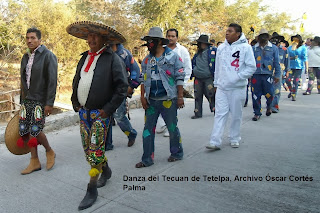TRADITIONAL DANCE AND ZAPATISTA REVOLUTION
By Óscar Cortés Palma
As we can see in the map below, the distribution of Dance of Tecuan and similar ones correspond to the same territorial distribution of the Zapatista movement during the Mexican Revolution, in the only places in this region where I have not registered this dance is because they are serranías Or very small rancherías of which we do not know their dances.
In the villages where the Dance of the Tecuan is danced, which I have already mentioned and which corresponds to the territorial strip that is in the boundaries between the states of Morelos, Guerrero, Puebla and Mexico, it is known that since the year of In 1888, the Dance of the Tecuan was danced in the town of Acatlan de Osorio, Puebla brought by "tecuaneros teachers" of some town of nahua filiation; And it is also known that in the town of Tetelpa, municipality of Zacatepec, Morelos, Ramón Sorela already organized the Dance of Tecuan in the year 1895, and is likely to organize it from many years before, so far are the oldest dates That I have about the existence of this dance.
Similarly there are manuscripts that mention the existence of the Tecuan Dance in 1910 in the town of Coatetelco, Morelos and by oral sources we know that before the Mexican revolution was already danced in Axochiapan, Morelos.
From the above I consider that this traditional dance was contemporary to the revolutionary peasants of the 1910s.
The Zapatista outbreak of the 1910s has been well studied, hundreds of books abound on the facts of arms, the political and economic situation during those years, but have not analyzed the culture and traditions of the region where it emerged This peasant rebellion.
He considered that the traditions were and still are essential for the daily life of these communities, for example, the inhabitants of this region invest many economic and human resources in the fairs of their Holy Patrons: stewardships, brotherhoods, traditional dances, Music, large communal meals, ornaments, are strong evidence that traditions must be studied to understand why peasant rebellion has arisen so strongly in this region and not in others.
Unfortunately there is very little literature on the traditional dances of those years, since the government's aim was to make the native settlers abandon their ancestral traditions and adopt the national culture.
But when we study traditional dances today we realize that the traditions are of long or medium historical duration, so it is probable that in the villages where the Dance of the Tecuan is currently danced, they have been dancing for many decades , Because this dance generally describes an aspect of the landlord or latifundista life and at present it has been almost a hundred years since there are no haciendas.
It is more than obvious that there is a relationship between the Dance of the Tecuan and its other dance variants that deal with the hunting of the Jaguar with the territory where the Zapatista rebellion of the 1910s was nurtured, so what I am trying to prove is that This traditional dance and other forms of community organization are a response of these societies to maintain their autonomy and independence, that is to say these traditional dances are related to peasant rebellion of this region probably from before and after to the Mexican Revolution.
I think that in order to understand the Zapatista rebellion, it is necessary to analyze the cultural traditions and networks that exist in the region where it was present, because only then will we explain why the peasant armed movement remained in this region for many years and not in another region.
If we overcome the traditional dance of the Tecuan and other dance variants of the hunting of a Jaguar, with the map of peasant rebellion of the decade of 1910, we will realize that the places where these dances are currently danced with the A region where there were rebellious uprisings before, during and after the Mexican Revolution.
© Óscar Cortés Palma
Book of the Tecuanes
Cel: 7351506920
Email: cami17_4@hotmail.com
Facebook.com/oscarcortespalma
Twitter: oscarcortespalm



.JPG)



No hay comentarios:
Publicar un comentario